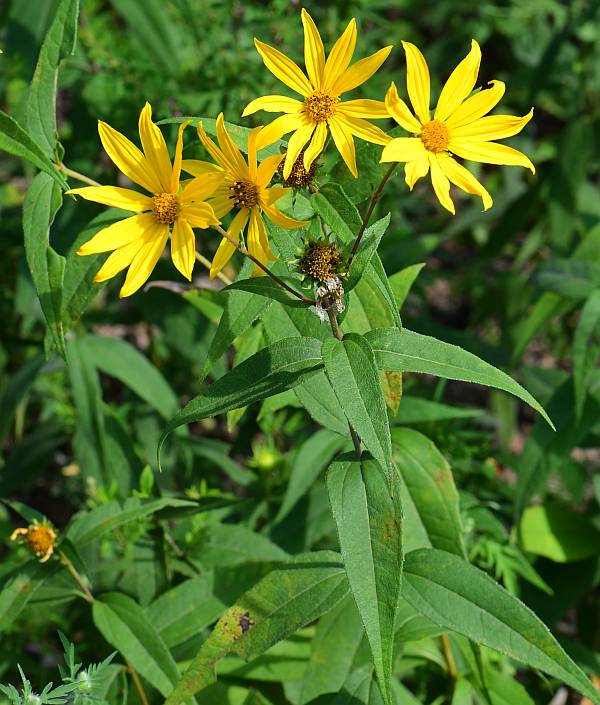Helianthus hirsutus Raf.
Hairy Sunflower

Native
CC = 4
CW = 5
MOC = 83
© SRTurner
Helianthus hirsutus Raf.Hairy Sunflower | |
 |
Native CC = 4 CW = 5 MOC = 83 |
© SRTurner |
|
Family - Asteraceae/Heliantheae Habit - Perennial forb with slender to stout, usually long-creeping, branched rhizomes (the branches sometimes slightly thickened at the tip but not with well-defined tubers), sometimes occurring in dense colonies. Stems - Erect, to 1.5 m, usually solitary, usually moderately to densely pubescent with short, stiff, loosely ascending, sometimes pustular-based hairs, sometimes nearly glabrous toward the base, not glaucous.
Leaves - Opposite, simple, petiolate, well-developed along the stem (usually 8 or more nodes). Petioles of the larger leaves 0.5-1.5 cm long. Blades 4-18 cm long, 0.7-6.0 cm wide, relatively thick-textured, narrowly lanceolate to ovate (mostly 2-7 times as long as wide), flat, not folded longitudinally, rounded to angled or short-tapered at the base, tapered to a sharply pointed tip, the margins finely toothed to entire, flat, the upper surface moderately to strongly roughened with moderate to dense, minute to short, stout, sometimes pustular-based hairs, the undersurface not whitened, moderately to densely pubescent with somewhat softer, loosely appressed to more or less spreading hairs, also with sparse to moderate, sessile, yellow glands, with 3 main veins, the lateral pair branching from the midnerve at or near the base of the blade, arching upward.
Inflorescences - Solitary terminal heads or appearing as open clusters or rarely open panicles. Heads - Involucre 8-14 mm long, 10-25 mm in diameter, about as long as or slightly longer than the tips of the disc corollas, the bracts in 3 or 4 subequal, overlapping series, narrowly lanceolate to lanceolate, tapered to a sharply pointed, loosely ascending to spreading or recurved tip, the margins with an irregular fringe of short, spreading to ascending hairs, the outer surface glabrous or sometimes sparsely to moderately pubescent with short, stout, ascending hairs, but usually lacking minute, sessile, yellow glands. Receptacle convex, the chaffy bracts 7-9 mm long, narrowly oblong to narrowly oblong-oblanceolate, usually with 3 short, sharply pointed lobes at the tip, these green or straw-colored, the outer surface minutely hairy, especially toward the tip.
Flowers - Ray florets 10-15, sterile, the corolla 1.5-3.0 cm long, bright yellow, the outer surface usually with sparse, minute hairs and scattered, minute, sessile, yellow glands. Disc florets perfect, the corollas 5.5-6.5 mm long, yellow, the lobes often minutely hairy on the outer surface. Pappus of 2 scales 2.5-3.5 mm long, these lanceolate to narrowly triangular, tapered to a sharply pointed, often minutely awnlike tip.
Fruits - Achenes 3.5-4.5 mm long, wedge-shaped to obovate, somewhat flattened and more or less bluntly 4-angled in cross-section, the surface glabrous or with a few minute hairs at the tip, uniformly brown or with fine, darker and lighter brown mottling.
Flowering - July - October. Habitat - Upland forests, savannas, upland prairies, sand prairies, ledges and tops of bluffs, streambanks, pastures, quarries, ditches, railroads, roadsides, and disturbed areas. Origin - Native to the U.S. Lookalikes - Differentiation from H. strumosus is difficult and controversial. Other lookalikes include H. divaricatus, H. tuberosus, Heliopsis helianthoides, and, more broadly, numerous other aster family species. Other info. - This species can be found throughout Missouri and is one of the most common of the sunflowers. Beyond Missouri it is found throughout most of the eastern half of the continental U.S., most abundantly in the Midwest. Photographs taken in the Peck Ranch Wildlife Refuge, Carter County, MO., 7-12-03, and off Hwy 60, Carter County, MO., 7-19-03 (DETenaglia); also at Shaw Nature Reserve, Franklin County, MO, 9-20-2007; and Don Robinson State Park, Jefferson County, MO, 8-10-2024 (SRTurner). |